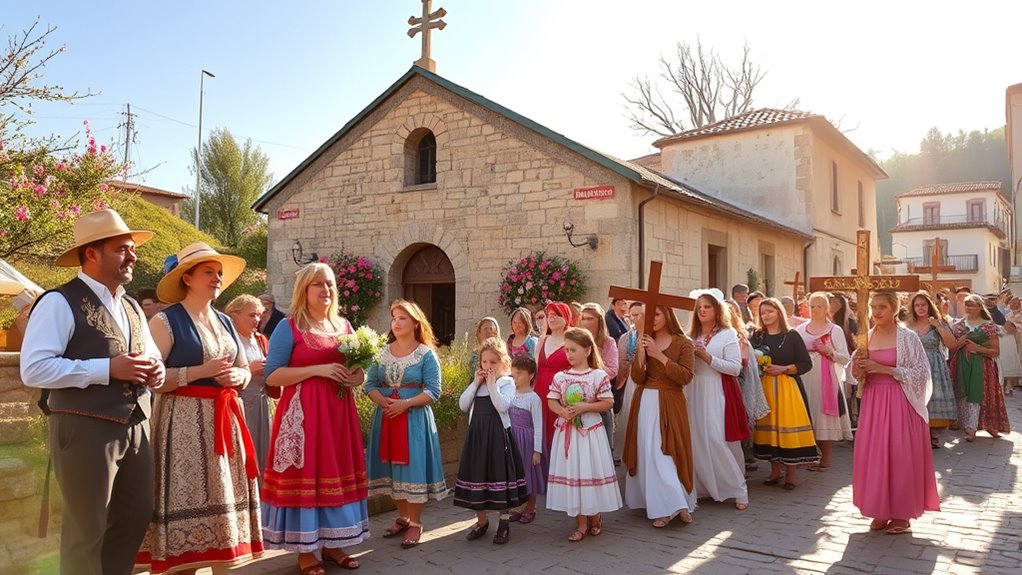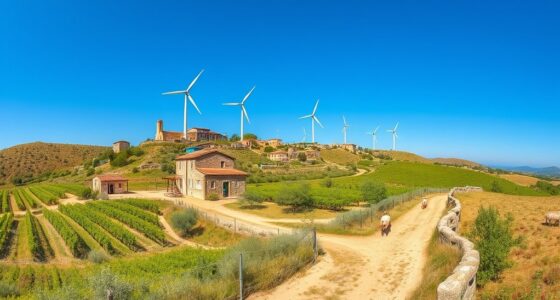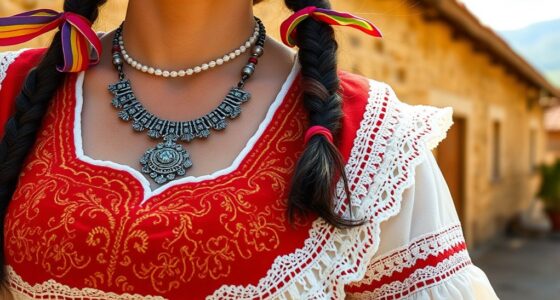Celebrating Easter in Sardinia means experiencing a rich mix of ancient customs, religious processions, and lively community events. You’ll witness dramatic Holy Week rituals like the Mysteries procession, solemn reenactments, and colorful outdoor celebrations. Unique regional customs, traditional foods, and vibrant costumes create an unforgettable atmosphere. Confraternities help preserve these traditions through centuries-old ceremonies. If you keep exploring, you’ll discover how Sardinian Easter truly embodies faith, culture, and community spirit.
Key Takeaways
- Sardinian Easter celebrations blend pagan, Jewish, and Christian traditions, emphasizing fertility, renewal, and community identity.
- Key rituals include processions of the Mysteries, Good Friday ceremonies, and the Easter Sunday S’Incontru reunions.
- Confraternities organize and preserve traditional rites like Misteri processions, S’Iscravamentu, and Holy Thursday dramatizations.
- Regional customs vary, with unique events like Spanish-influenced Cerques in Alghero and Passion plays in Oristano.
- Traditional foods such as decorated bread, lamb dishes, and ricotta pastries play a central role in cultural festivities.
The Roots of Easter Celebrations in Sardinia
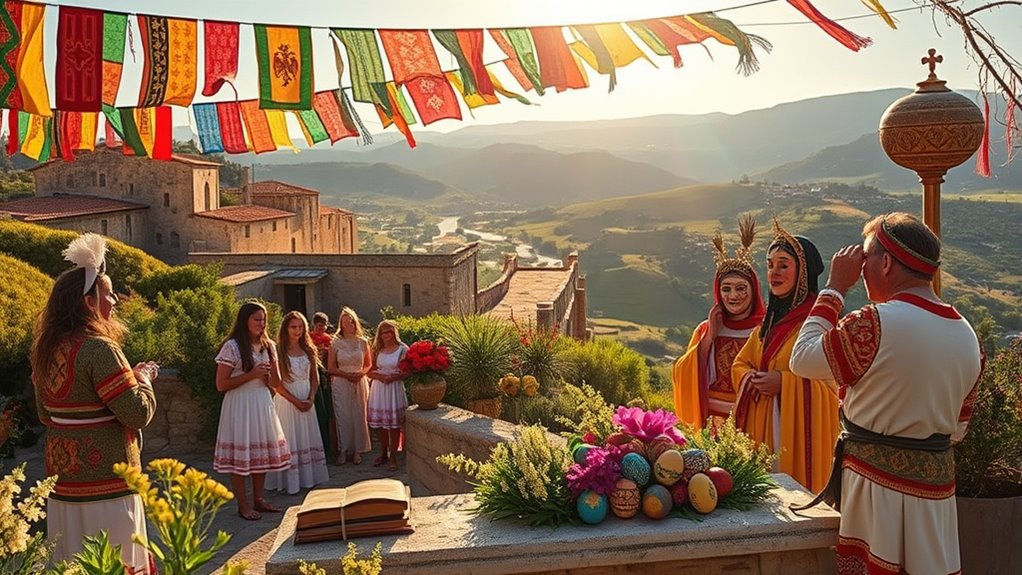
The roots of Easter celebrations in Sardinia stretch back to pre-Christian times when communities marked the arrival of Spring with rituals aimed at ensuring fertility and bountiful harvests. You’d see ancient rites focused on honoring nature and seasonal renewal, often involving pagan Mediterranean gods linked to land fertility and agriculture. These early ceremonies included prayers and rituals designed to protect crops, livestock, and communities, emphasizing abundance and prosperity. Archaeological findings have uncovered remnants of sacred sites and artifacts associated with these early fertility rites, illustrating their importance in ancient Sardinian society. Moreover, the locations of these sacred sites often align with ancient fertility symbols, underscoring their spiritual significance. Over time, these pagan practices blended with Jewish and Christian traditions, creating a fusion of beliefs that shaped modern Easter celebrations. Today, this rich history persists through customs that symbolize both the natural cycle of renewal and the Passion of Christ, reflecting Sardinia’s unique cultural tapestry rooted in ancient fertility rites and religious evolution.
Key Rituals and Processions During Holy Week
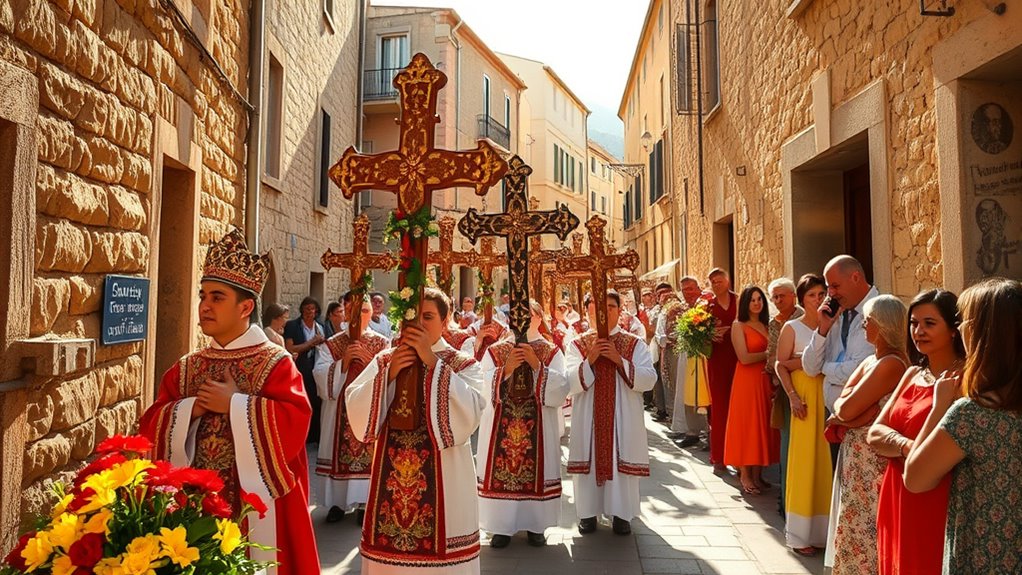
During Holy Week in Sardinia, vibrant processions and solemn rituals bring centuries-old traditions to life, drawing communities together in devotion. You’ll witness the Procession of the Mysteries on the Friday before Palm Sunday, where seven statues depicting Christ’s Passion are carried through streets. On Good Friday, the Procession of Monte re-enacts Jesus’ ascent to Calvary with children carrying crosses and traditional instruments echoing through the air. Later, the Procession of Descenso solemnly portrays Jesus’ funeral, while the Sas Chilcas Procession involves devotees accompanying the Virgin Mary searching for her son. The Procession of S’Iscravamentu marks the removal of nails from Christ’s statue, completing the day’s rituals. These processions, accompanied by drums, traditional costumes, and candlelight, create a deeply emotional and communal atmosphere that embodies Sardinia’s enduring faith. Incorporating emotional intelligence into these observances enhances the collective experience, fostering a sense of unity and spiritual reflection among participants.
The Role of Confraternities in Preserving Traditions
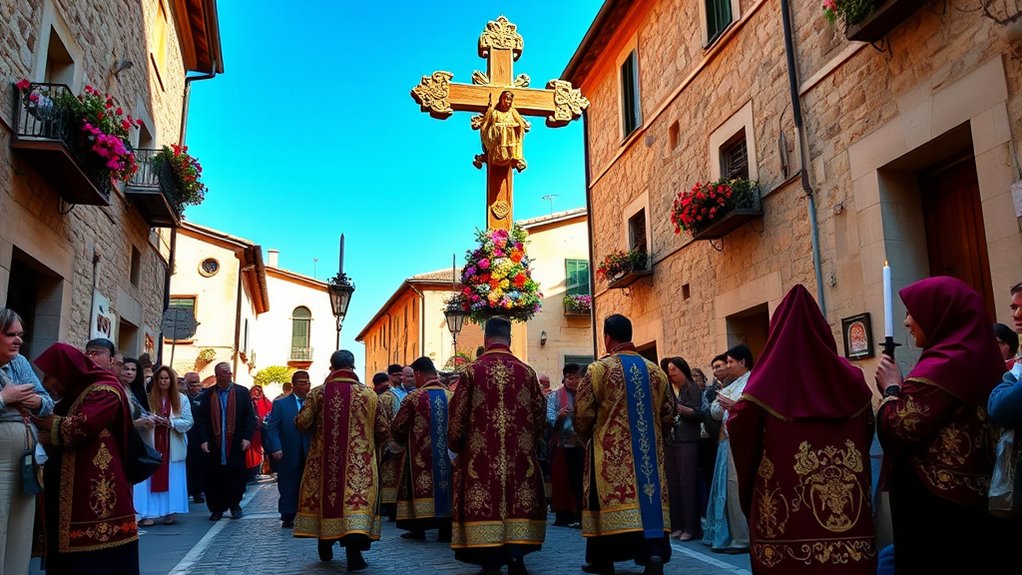
Confraternities have long been the backbone of Sardinia’s Easter traditions, organizing and safeguarding the rites that have been passed down through generations. They are responsible for key ceremonies like Misteri processions, S’Iscravamentu, and S’incontru, ensuring these customs survive annually. You’ll see them manage processions, care for statues, and coordinate participants, blending religious and community duties. Their role involves:
- Leading Passion processions, carrying statues of Christ and the Virgin through town streets.
- Recreating the Last Supper on Maundy Thursday with blessing and sharing bread and wine.
- Preparing for Easter Vigil by lighting candles, uncovering statues, and organizing solemn acts.
- Their efforts are also crucial in preserving cultural continuity, ensuring that Sardinian Easter traditions are maintained and celebrated by future generations.
Through these efforts, confraternities preserve Sardinia’s unique fusion of Christian and pre-Christian traditions, maintaining cultural continuity across generations.
Variations Across Towns and Villages
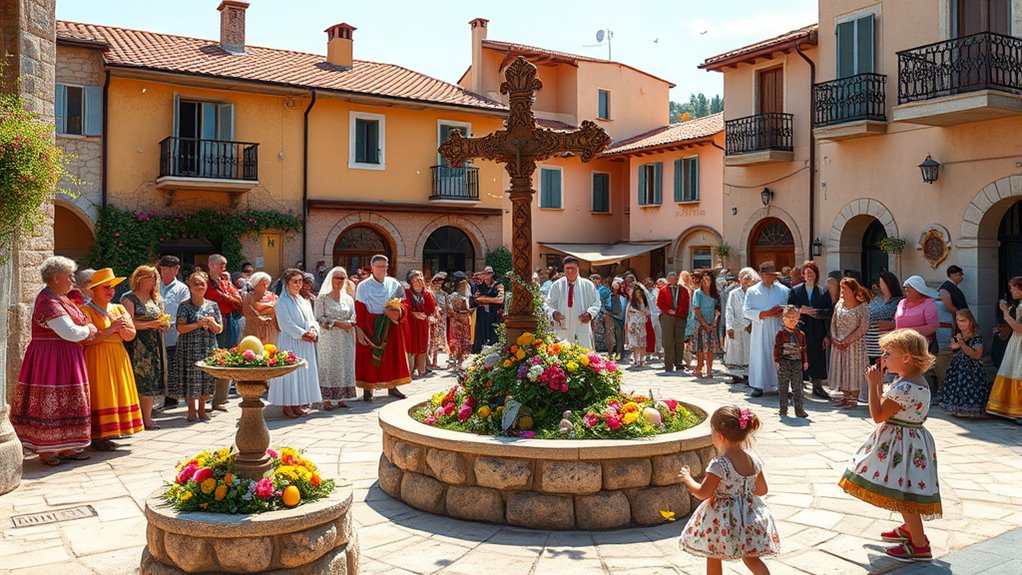
Across Sardinia, Easter traditions vary considerably from town to town, reflecting local history, cultural influences, and community identity. In Alghero, Spanish customs shine through with Cerques and Desclavament, while S’Incontru on Easter Sunday celebrates a joyful, Hispanic-rooted reunion at the Bastions. Cagliari combines pagan and Christian rites, with decorated palm branches, Via Crucis processions, and festive outdoor picnics on Easter Monday. Oristano and central Sardinia feature dramatic Passion plays, medieval equestrian events like Sartiglia, and processions with biblical costumes. Nuoro and eastern villages embrace folk rituals, symbolic gestures like bread with eggs, and spontaneous singing, blending pre-Christian symbols with Christian themes. Many small villages craft unique practices, adapting traditional rites to their local heritage, creating a rich mosaic of Easter celebrations across Sardinia. These regional variations highlight the cultural diversity that makes Sardinian Easter festivities uniquely vibrant and meaningful.
Culinary Delights of the Easter Season
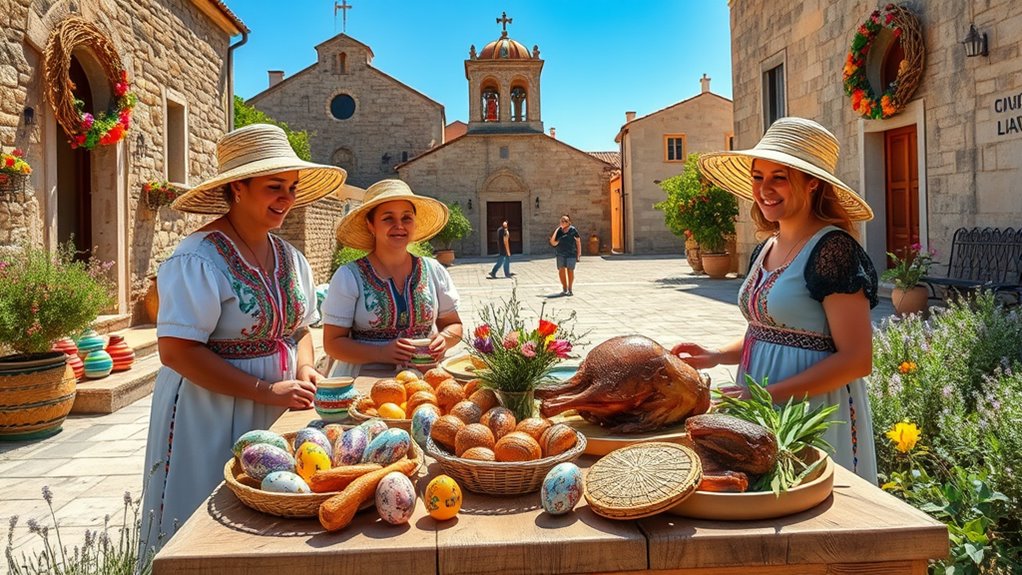
During Easter in Sardinia, the culinary scene comes alive with traditional breads and festive dishes that symbolize renewal and community. You’ll find unique breads like *coccoi cun s’ou* and others decorated with creative motifs, often containing symbolic ingredients. Alongside these, lamb dishes and sweet pastries made with local cheeses and flavors complete the rich, meaningful celebration. Bread is a central element, crafted with artisanal skill for special occasions, and many bakers incorporate traditional baking techniques to preserve the authenticity of these festive treats.
Traditional Easter Breads
One of the most iconic Easter treats in Sardinia is the Coccoi cun s’ou, a traditional bread that embodies the island’s rich cultural and religious heritage. You’ll notice it’s made from durum wheat semolina, with a raw egg placed at the center that cooks during baking, symbolizing rebirth. The dough is shaped into crowns or other forms and decorated creatively with motifs like wheels, flowers, or fish using knives and scissors. To make it, you should:
- Dissolve yeast in warm water and let it rise for 8-10 hours.
- Shape the dough into various sizes and forms reflecting local customs.
- Decorate with symbols of fertility and life before baking, allowing the egg to cook inside.
- The decorative process often involves traditional tools, emphasizing craftsmanship and artistry, which is a significant cultural tradition in Sardinian Easter celebrations. Additionally, understanding the Easter customs in Sardinia helps appreciate the symbolism behind each decorative element.
Festive Sardinian Dishes
Festive Sardinian dishes showcase a rich tapestry of flavors that highlight the island’s culinary traditions during Easter. You’ll find ricotta-based desserts like pardulas, star-shaped tartlets filled with sheep’s milk ricotta, saffron, and citrus peel. These sweet treats have a soft, spongy texture and are often dusted with icing sugar or decorated with honey and sprinkles, symbolizing celebration. Lamb remains central to the feast, typically paired with artichokes seasoned with lemon, garlic, and parsley, emphasizing fresh, local ingredients. Pardulas are traditionally served warm, often with sprinkles or dusted with icing sugar. Savory dishes often feature cheese and eggs, symbolizing fertility and rebirth, and are served as communal favorites. Additionally, traditional pastries like casadinas, filled with ricotta and flavored with honey or raisins, showcase the island’s dairy heritage and festive spirit. Incorporating colorful presentation techniques enhances the visual appeal of these festive offerings, making the celebration even more vibrant.
The Significance of Holy Week’s Public Events
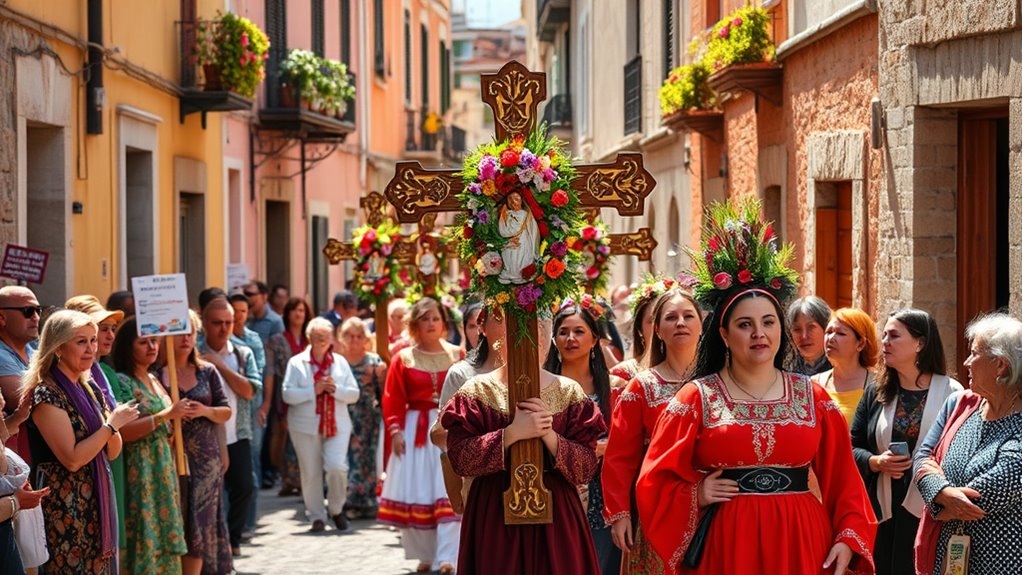
Holy Week’s public events in Sardinia hold deep cultural and spiritual significance, serving as powerful expressions of faith and community identity. These events forge a strong sense of unity and tradition among locals and visitors alike. The confraternities organize processions that re-enact Christ’s life, involving centuries-old statues and rituals. To understand their importance: cultural heritage they symbolize key moments in Christ’s Passion, like the Procession of the Mysteries and Good Friday ceremonies. They preserve centuries-old customs, connecting communities with their historical roots. They foster community spirit, bringing townspeople together across generations. These public events showcase Sardinia’s rich religious heritage, making Holy Week a profound time for reflection, cultural pride, and shared experience. They also draw tourists, helping sustain local traditions and economies.
Unique Local Customs and Cultural Highlights

In Sardinia, Easter customs blend ancient spring rituals with Christian traditions, creating a unique cultural tapestry that captivates both locals and visitors. During *Sa Pasca Manna*, a mix of pre-Christian rites and Christian practices, you’ll see special processions like the *Lunissanti*, a Holy Monday pilgrimage to Abbey Nostra Signora di Tergu that shows community faith and endurance. The *Prucissiuni* on Holy Thursday dramatizes the meeting of Holy Mary and Christ, while Good Friday’s *Ilcravamentu* features silent depictions of Jesus’ deposition. On Easter Sunday, the *S’Incontru* reunites the statues of the Risen Christ and the Madonna, creating a powerful, emotional spectacle. Local brotherhoods, or *Confraternite*, organize these events, blending sacred music, chants, and community involvement to keep these traditions alive and vibrant. These traditions are often passed down through generations, ensuring the preservation of Sardinia’s rich cultural heritage. Additionally, some communities incorporate Gold IRA elements into their celebrations, symbolizing prosperity and hope for the future.
Frequently Asked Questions
How Do Sardinian Easter Traditions Blend Pagan and Christian Elements?
You see how Sardinian Easter traditions blend pagan and Christian elements seamlessly. You participate in rituals like planting buds (*Su Nènniri*), symbolizing rebirth, alongside Christian processions and reenactments of biblical scenes. You observe fasting and purification rites rooted in ancient practices, while also engaging in theatrical Holy Week ceremonies. This fusion creates a rich spiritual experience that celebrates both earth’s renewal and Christ’s resurrection, reflecting a deep cultural continuity.
What Are the Symbolic Meanings Behind the Processions and Hymns?
You see that the processions and hymns symbolize deep spiritual themes. The slow, torch-lit marches reenact Christ’s Passion, representing suffering and hope. Baballottis and sacred relics embody penitence and mourning, connecting you with ancestral faith. Hymns and Gregorian chants evoke solemnity, reverence, and the triumph of resurrection. Together, they reinforce themes of sacrifice, renewal, and community, creating a powerful, timeless experience that links you to spiritual history and collective hope.
How Do Local Confraternities Maintain and Pass Down Customs?
You play a crucial role in how confraternities maintain and pass down customs. They organize and rehearse rituals, passing knowledge orally and through active participation. You can involve younger generations by teaching them craft skills, singing hymns, and participating in processions. By staying committed and sharing traditions, you help guarantee these customs remain authentic, meaningful, and alive for future generations, preserving Sardinian cultural and religious identity.
What Are Some Unique Regional Variations in Easter Celebrations?
Imagine a tapestry woven with different threads—each Sardinian town adds its own vibrant color to Easter celebrations. You’ll notice regional variations like Alghero’s Spanish-influenced Cerques and Desclavament rituals or towns that use live actors in processions. Music, chants, and customs shift from place to place, creating a unique mosaic of traditions. These differences reflect local history, cultural influences, and community identity, making each celebration a special reflection of its roots.
Which Traditional Foods Are Essential During Sardinian Easter Festivities?
During Sardinian Easter festivities, you’ll find that traditional foods play a essential role. You’ll enjoy symbolic breads like Coccoi cun s’ou, topped with a raw egg, representing renewal. Lamb dishes, especially kid lamb roasted on a spit, symbolize sacrifice and family unity. For sweets, Pardulas and formagelle, filled with ricotta and flavored with saffron and citrus, add a festive touch. These foods connect deeply to the island’s cultural and religious traditions.
Conclusion
As you experience Sardinia’s Easter traditions, you’ll find a blend of ancient rituals and lively celebrations that breathe life into the island. While solemn processions evoke reverence, colorful festivals ignite joy. The contrast between reflective moments and spirited festivities captures the true spirit of Holy Week. In Sardinia, history and culture dance together, inviting you to witness a timeless celebration that’s both deeply rooted and vibrantly alive.
